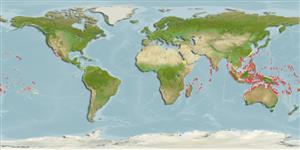>
Ovalentaria/misc (Various families in series Ovalentaria) >
Pomacentridae (Damselfishes) > Microspathodontinae
Etymology: Plectroglyphidodon: Greek,plektron = anything to strike with, spur + Greek, glyphis = carved + Greek, odous = teeth (Ref. 45335).
Eponymy: The Honorable George F Dick was Colonial Secretary of Mauritius and the President of the Natural History Society of Mauritius (1836–1850). He retired to his native Ireland. (Ref. 128868), visit book page.
Environment: milieu / climate zone / depth range / distribution range
Ökologie
seewasser riff-verbunden; standorttreu; tiefenbereich 0 - 20 m (Ref. 128797). Tropical; 30°N - 30°S
Indo-Pacific: East Africa to the Line and Tuamoto islands, north to Japan, south to Australia.
Size / Gewicht / Alter
Maturity: Lm ? range ? - ? cm
Max length : 11.6 cm TL Männchen/unbestimmt; (Ref. 124696); max. veröff. Gewicht: 35.62 g (Ref. 124696)
Rückenflossenstacheln (insgesamt) : 12; Rückenflossenweichstrahlen (insgesamt) : 16 - 18; Afterflossenstacheln: 2; Afterflossenweichstrahlen: 14 - 16.
Adults inhabit coral-rich and surge areas of clear lagoon and seaward reefs (Ref. 1602). Commonly associated with Pocillopora or Acropora corals (Ref. 1602). Feed on filamentous algae, small benthic invertebrates, and occasionally small fishes (Ref. 1602). Oviparous, distinct pairing during breeding (Ref. 205). Eggs are demersal and adhere to the substrate (Ref. 205). Males guard and aerate the eggs (Ref. 205). Diurnal species (Ref. 54980; 113699).
Life cycle and mating behavior
Geschlechtsreife | Fortpflanzung | Ablaichen | Eier | Fecundity | Larven
Oviparous, distinct pairing during breeding (Ref. 205). Eggs are demersal and adhere to the substrate (Ref. 205). Males guard and aerate the eggs (Ref. 205).
Allen, G.R., 1991. Damselfishes of the world. Mergus Publishers, Melle, Germany. 271 p. (Ref. 7247)
IUCN Rote Liste Status (Ref. 130435: Version 2024-2)
Bedrohung für Menschen
Harmless
Nutzung durch Menschen
Fischereien: weniger kommerziell; Aquarium: Kommerziell
Tools
Zusatzinformationen
Download XML
Internet Quellen
Estimates based on models
Preferred temperature (Ref.
123201): 25 - 29.3, mean 28.3 °C (based on 2789 cells).
Phylogenetic diversity index (Ref.
82804): PD
50 = 0.5010 [Uniqueness, from 0.5 = low to 2.0 = high].
Bayesian length-weight: a=0.02042 (0.01167 - 0.03573), b=2.98 (2.82 - 3.14), in cm total length, based on LWR estimates for this species & (Sub)family-body (Ref.
93245).
Trophic level (Ref.
69278): 3.7 ±0.3 se; based on diet studies.
Widerstandsfähigkeit (Ref.
120179): hoch, Verdopplung der Population dauert weniger als 15 Monate. (Preliminary K or Fecundity.).
Fishing Vulnerability (Ref.
59153): Low vulnerability (10 of 100).
Nutrients (Ref.
124155): Calcium = 99.9 [49.4, 166.6] mg/100g; Iron = 0.679 [0.390, 1.141] mg/100g; Protein = 18.6 [17.4, 19.7] %; Omega3 = 0.119 [0.069, 0.199] g/100g; Selenium = 19.1 [10.3, 38.1] μg/100g; VitaminA = 119 [35, 402] μg/100g; Zinc = 1.48 [0.97, 2.16] mg/100g (wet weight);
